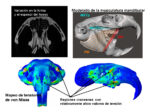Análisis estructural del cráneo del tuco tuco de los talas, Ctenomys talarum (Rodentia, Caviomorpha) ante esfuerzos de mordida
Guido N. Buezas, Federico Becerra, Aldo I. VassalloCtenomys talarum (peso corporal ∼150 g) puede morder con los incisivos con una fuerza mayor de 3 kgf, por lo que estas piezas dentarias soportan un esfuerzo (fuerza de reacción) unas 20 veces mayor que su peso corporal. Las fuerzas de reacción que reciben los dientes al morder son transmitidas al resto del cráneo por los huesos y otros tejidos que lo constituyen. ¿Cómo se comporta estructuralmente el cráneo ante estos esfuerzos? Mediante el análisis de elementos finitos se estimó la tensión en el cráneo de C. talarum ante fuerzas de mordida aplicadas tanto sobre los incisivos superiores, al simular la acción de roer, como sobre el premolar 4 superior, al simular la trituración de alimentos. La mordida con incisivos produjo una tensión elevada en la cavidad glenoidea y en la arcada cigomática, de 47,8 y 17,8 megapascales (MPa), respectivamente. La masticación unilateral (i.e., fuerza aplicada sobre el premolar 4 de un único lado del cráneo) generó valores de tensión relativamente mayores, comparados con los de roedura, entre los que se destacan los incrementos en la barra preorbitaria y en la arcada cigomática, con valores de 27,5 y 31,5 MPa, respectivamente. En ambas simulaciones de mordida, los factores de seguridad (i.e., cociente entre la capacidad máxima de soporte estructural y el esfuerzo real al que se ve sometido el cráneo) fueron elevados, y ningún valor fue inferior a 3. Los valores de tensión disímiles entre regiones equivalentes a derecha e izquierda, alternadamente mayores de uno u otro lado a lo largo del cráneo y durante la masticación unilateral, sugieren la existencia de un esfuerzo de torsión que actúa sobre el eje longitudinal del cráneo.
Structural analysis of the skull of the talas’ tuco tuco, Ctenomys talarum (Rodentia, Caviomorpha) under bite efforts. An incisor bite by a talas’ tuco tuco (Ctenomys talarum, body weight ∼150 g) may reach values over 3 kgf so that the incisor supports an effort (reaction force) about 20 times greater than the body weight of the animal. Reaction forces that teeth locally receive while biting are transmitted to the rest of the skull by the bones and other constitutive tissues. Thus, a question arises about how the skull structurally behaves at facing these mechanical stresses. Finite element analyses were used to estimate stresses in the cranium of C. talarum under biting efforts on either the upper incisors when simulating gnawing, or the upper premolar 4 when simulating grinding foods. Incisor biting produced relatively high stresses in the glenoid cavity and in the zygomatic arch, 47.8 and 17.8 megapascals (MPa), respectively. Unilateral chewing (i.e., force being applied to premolar 4 only on one side of the skull) yielded relatively higher stress values compared to gnawing. Increases in stress at the preorbital bar and the anterior region of the zygomatic arch stand out, with values of 27.5 and 31.5 MPa, respectively. In both biting simulations, safety factors (i.e., the quotient between the maximum structural capacity and the real stress produced by loadings upon the cranium) were high, not observing any value lower than 3. Dissimilar stress values between equivalent left- and right-sided regions, being alternatively higher on one side or the other across the skull and during unilateral chewing, suggest the existence of torsional forces acting along the longitudinal axis of the skull.
